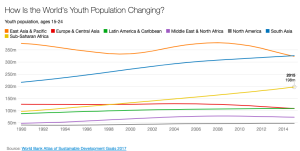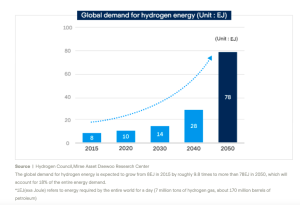Youth For Green Hydrogen
Why do we need to strengthen youth participation in Green Hydrogen?
By Sailesh Singhal, Erik Solheim and Ravi Karkara
The number of youth between the ages of 15 and 24 is 1.1 billion; youth constitute 18 percent of the global population. Youth and children together, including all those aged 24 years and younger, account for nearly 40 percent of the world’s population. The number of youth in the world is projected to grow by 7 per cent to 1.3 billion by 2030, the target date for achieving the Sustainable Development Goals (SDGs). Around 2065, the world’s youth population is projected to reach its peak, at just under 1.4 billion persons (13%). The share of youth in the total population peaked at 19.3 per cent in 1985. In 2019, Central and Southern Asia were home to the largest number of youth (361 million), followed by Eastern and South-Eastern Asia (307 million) and sub-Saharan Africa (211 million). In the 47 least developed countries, the youth population is projected to increase by 62 per cent over the next three decades, rising from 207 million in 2019 to 336 million in 2050. The largest increases are expected in sub-Saharan Africa (+89%), Oceania3 (+38%) and Northern Africa and Western Asia (+28%)

Millennials and Generation Zs came of age at the same time that online platforms and social media gave them the ability and power to share their opinions, influence distant people and institutions, and question authority in new ways. These forces have shaped their worldviews, values, and behaviors. Environment remains a priority Climate change/protecting the environment (28% in 2020) was easily millennials’ top personal concern a year ago, by a margin of six percentage points. Though it gained one percentage point in the April survey, it slipped to number two among concerns. This year, unemployment fears leapfrogged it, dropping it to third. Still, it’s somewhat remarkable that respondents’ minds remained focused on environmental issues when threats to their health, family welfare, and careers are more personal and imminent. In last year’s pre-pandemic survey, half of all respondents said they feared the environment had passed the point of no return and it was too late to repair the damage caused by climate change. Those figures, though still high, fell this year to 44% for millennials and 43% for Gen Zs. Encouraging environmental signs witnessed during the pandemic lockdown may have stoked optimism. On the flip side, approximately 60% of millennials and Gen Zs fear that business’ commitment to reversing climate change and improving the environment will be less of a priority as business leaders reckon with challenges presented by the pandemic and other developments.
Although scientists have been warning of the peril of global warming and climate change for decades, leaders across the world have been slow to respond, casting doubt on humanity’s future. More than anyone else, that future belongs to young people. According to a new survey led by researchers from the University of Bath in the United Kingdom, most young people are worried and angry about what they see ahead. It is a future they feel should have been, and still could be, prevented by an older generation not doing enough to prevent it. The survey questioned 10,000 young people, aged 16–25 years, in 10 countries. The countries were the U.K., the United States, Australia, Brazil, Finland, France, India, Nigeria, the Philippines, and Portugal. Overall, 75% of young respondents said, “the future is frightening
Why Green hydrogen? Green hydrogen is defined as hydrogen produced by splitting water into hydrogen and oxygen using renewable electricity through a process called electrolysis. This results in very low or zero carbon emissions. Emerging green hydrogen strategies and policies differ widely on the definition of “renewable energy”, the boundaries of the carbon accounting system, the emission thresholds at which hydrogen is considered green, and the feedstocks and production technologies deployed. This lack of standardisation is undermining efforts to accelerate the use of green hydrogen.

Young leaders from around the world issued a clear call to action to reset the energy transition, and they urged more young people to join them in demanding bolder clean energy and climate progress Inequalities and discrimination faced by young people in the renewable energy workforce prevent too many of them from realizing their full potential as agents of change. This means that the sector is missing out on benefiting from an entire talent pool. To unlock jobs and economic opportunities in the renewable energy sector, young people need a formal seat at the energy transition decision-making table. Inclusion of young people in the energy transition will not be achieved through a “business as usual approach”.
There are serious intersectional equity concerns that need to be addressed in the energy industry at large as we work to change the system. “The clean energy economy workforce is older, dominated by male workers, and lacks racial diversity when compared to all occupations nationally. Fewer than 20 percent of workers in the clean energy production and energy efficiency sectors are women, while black workers fill less than ten percent of these sector’s jobs,” states a recent Brookings Institute report.
The need to involve young women and young men in Green Hydrogen is immediate. It is in the above context that Youth for Green Hydrogen has been created with the following areas of interventions:
- Awareness:
- Investing in youth leadership in creating awareness on Green Hydrogen is critical to bring a paradigm shift in energy consumption by commit to use renewable energy across all channels.
- Work through public private partnerships to carry out awareness on Green Hydrogen.
- Advocacy:
- Youth lead a demand for creation of a Global Green Hydrogen Day
- Encourage youth engagement in Green Hydrogen polices and implementations
- Create a Global Task Force of Youth For Green Hydrogen young women and men to work closely with Green Hydrogen Global Assembly
- Host the first-ever Youth For Green Hydrogen Global Assembly in India in strengthening the vision of Green Hydrogen Organization
- Capacity Building:
- Develop online initiatives to build capacity of young people to participate and promote a culture of Green Hydrogen.
- Organize Youth For Green Hydrogen Innovation Challenge
- Engage and encourage universities across the globe to host dialogues, discussions and research on Green Hydrogen
- Youth Entrepreneurs
- Invest in youth entrepreneurship & entrepreneurial initiatives.
- Partners with investors and market leaders to support Green Hydrogen incubators for young women and men entrepreneurs
- Youth Lead Innovation
- Nestle youth led innovation to localize the production and use of Green Hydrogen.
- Support youth to create low cost innovation in advancing production and consumption of Green Hydrogen.
- Strengthen 50% young women leadership in Green Hydrogen at local to global levels
- Support and include marginalized and indigenous youth in Green Hydrogen initiatives
- To involve Youth in impact measurement of Green Hydrogen economy. Youth should evaluate the impact of Green Hydrogen in societies.
- To create a Global Youth For Green Hydrogen Innovation Fund to encourage youth led initiatives to rapidly increase support for Green Hydrogen research, low-cost production and supply of consumption in countries and emerging markets
Conclusion
Inter-generational partnerships are key for mainstreaming Green Hydrogen in everyday life. Green Hydrogen economy can only be created if all ages and diversities work together for a Green Today and a Green Tomorrow.


Leave a Reply